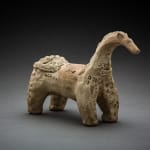Indus Valley Terracotta Zoomorphic Sculpture, 3500 BCE - 2500 BCE
Terracotta
12.1 x 17.1 cm
4 3/4 x 6 3/4 in
4 3/4 x 6 3/4 in
LO.503
Further images
The Indus Civilization still represents very much an archaeological conundrum: an ancient civilization with a yet-to be deciphered writing system, a mysterious monumental architecture, no so-called 'monumental' art, a puzzling...
The Indus Civilization still represents very much an archaeological conundrum: an ancient civilization with a yet-to be deciphered writing system, a mysterious monumental architecture, no so-called 'monumental' art, a puzzling decline, and little evidence of the identity of its direct descendants. In a civilization extending over an area so vast, one would expect to find monumental art and/or architectural symbols of power displaying the names of the powerful. Instead, the emphasis is placed on small, elegant art and sophisticated craft technology.
Three-dimensional representations of living beings in the Harappan world are confined to a few stone and bronze statues and some small objects crafted in faience, stone, and other materials - with one important exception. Ranging variously in size, the anthropomorphic and animal terracotta figurines the Indus Civilization sites depict life as seen by the Harappan people in the Bronze Age.
The earliest animal figurines from Harappa date back to the Early Harappan (Ravi Phase, Period 1 and Kot Diji Phase, Period 2) and mostly depict zebu bulls. Yet many different animals were indeed portrayed during the Early Harappan phase, including rams, pigs, dogs, bears, monkeys, birds, rhinos. The animal here portrayed would seem to recall an anteater. The dotted applied decoration on the front and hind legs is commonly found on depictions of rhinos from Harappa. The gentle curve of the neck and the applied ears and eyes enhance the realism while giving this small animal an unexpected sweetness.
For comparable examples see:
J-F Jarrige, Les Cites Oubliees de l'Indus, Guimet Museum, 1988.
Three-dimensional representations of living beings in the Harappan world are confined to a few stone and bronze statues and some small objects crafted in faience, stone, and other materials - with one important exception. Ranging variously in size, the anthropomorphic and animal terracotta figurines the Indus Civilization sites depict life as seen by the Harappan people in the Bronze Age.
The earliest animal figurines from Harappa date back to the Early Harappan (Ravi Phase, Period 1 and Kot Diji Phase, Period 2) and mostly depict zebu bulls. Yet many different animals were indeed portrayed during the Early Harappan phase, including rams, pigs, dogs, bears, monkeys, birds, rhinos. The animal here portrayed would seem to recall an anteater. The dotted applied decoration on the front and hind legs is commonly found on depictions of rhinos from Harappa. The gentle curve of the neck and the applied ears and eyes enhance the realism while giving this small animal an unexpected sweetness.
For comparable examples see:
J-F Jarrige, Les Cites Oubliees de l'Indus, Guimet Museum, 1988.







